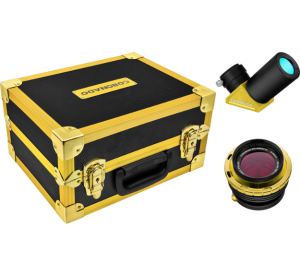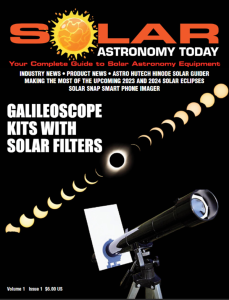The Coronado SolarMax III RichView Filter Set for solar viewing and imaging is available in a number of configurations offering a high performing Hydrogen-alpha filter design that includes a SolarMax III Etalon with blocking filter. Each set offers an external front mounted etalon for use on a high-quality telescope that incorporates a narrow 0.7 Angstrom bandpass ideal for viewing prominences on the solar limb.
 Each kit also includes a Coronado right angle (diagonal) type Hydrogen-alpha blocking filter, now in the SolarMax III design. This updated design includes a long 2″ diameter nosepiece with 1.25″ eyepiece holder and t-thread connection. The blocking filter is the second element in any Coronado H-alpha system and is just as crucial to your safety and the system’s performance as the primary SolarMax etalon filter. This blocking filter cannot be used without a SolarMax etalon.
Each kit also includes a Coronado right angle (diagonal) type Hydrogen-alpha blocking filter, now in the SolarMax III design. This updated design includes a long 2″ diameter nosepiece with 1.25″ eyepiece holder and t-thread connection. The blocking filter is the second element in any Coronado H-alpha system and is just as crucial to your safety and the system’s performance as the primary SolarMax etalon filter. This blocking filter cannot be used without a SolarMax etalon.
Coronado SolarMax III RichView Filter Set’s etalon includes Meade’s patented RichView tuning which allows direct tuning of the etalon filter. The RichView tuning system adjusts the distance between the etalons parallel glass plates in order to achieve the perfect wavelength bandpass for the feature you are observing, all while maintaining precise optical alignment. Coronado’s technology allows the etalon to be used at high altitude observing locations. The RichView system allows for improved control over your H-a bandpass window. In addition to RichView tuning, the included T-Max Tuner allows you to tune in the brightest image and remove any internal reflections.
The blocking filter is a convertible design and ideal for imaging the Sun. Convert from the 1.25″ right angle configuration to a 2″ straight design with the included straight-thru adapter. Also includes Coronado’s zero-length 2″ to 1.25″ adapter so you can use all your favorite 1.25″ accessories.
When properly and safely mounted on a high-quality refractor or other suitable telescope, the Coronado SolarMax III RichView Filter Set allows observation and imaging of the amazing and ever-changing surface detail and prominences on the Sun in Hydrogen-alpha light. It is not for use on truss-tube telescopes with open sides as unfiltered sunlight may be transmitted through the optical tube. Custom mounting of the etalon to your optical tube will be required. End-users may need to contract a third-party company to provide or machine any necessary adapters as adapters not included.
Coronado SolarMax III 60mm Solar Filter Set
The Coronado SolarMax III 60mm Solar Filter set with RichView tuning system includes a 60mm diameter primary Hydrogen-alpha etalon filter and is available in the following configurations:
– Front mounted external etalon with sub angstrom bandwidth and 30mm blocking filter. For telescopes with a focal length of 3,000mm or less.
– Front mounted external etalon with sub 0.7 angstrom bandwidth and 15mm blocking filter. For telescopes with a focal length of 1,500mm or less.
– Front mounted external etalon with sub 0.7 angstrom bandwidth and 10mm blocking filter. For telescopes with a focal length of 1,000mm or less.
Coronado SolarMax III 90mm Solar Filter Set
The Coronado SolarMax III 90mm Solar Filter set with RichView tuning system includes a 90mm diameter primary Hydrogen-alpha etalon filter and is available in the following configurations.
– Front mounted external etalon with sub 0.7 angstrom bandwidth and 15mm blocking filter. For telescopes with a focal length of 1,500mm or less.
– Front mounted external etalon with sub 0.7 angstrom bandwidth and 30mm blocking filter. For telescopes with a focal length of 3,000mm or less.
You can learn more about the Coronado SolarMax III RichView Filter Set here.

 And to make it easier for you to get the most extensive news, articles and reviews that are only available in the magazine pages of Astronomy Technology Today, we are offering a 1-year magazine subscription for only $6! Or, for an even better deal, we are offering 2 years for only $9. Click here to get these deals which only will be available for a very limited time. You can also check out a free sample issue here.
And to make it easier for you to get the most extensive news, articles and reviews that are only available in the magazine pages of Astronomy Technology Today, we are offering a 1-year magazine subscription for only $6! Or, for an even better deal, we are offering 2 years for only $9. Click here to get these deals which only will be available for a very limited time. You can also check out a free sample issue here.
The Sun is more active than it’s been in years and if that’s not enough, we have the Annular Solar Eclipse on October 14, 2023 and the Total Solar Eclipse on April 8, 2024! If you’d like to learn more about the technology behind solar observing, solar imaging and more, you can check out our new monthly magazine – Solar Astronomy Today. It’s free to read, no subscription needed and available here. And if you are preparing for the upcoming eclipses and want to know your equipment options from solar glasses to the most out of this world solar viewing and imaging options, check out our free publication – The Definitive Guide to Viewing and Imaging the Sun – simply click here and enjoy reading!

